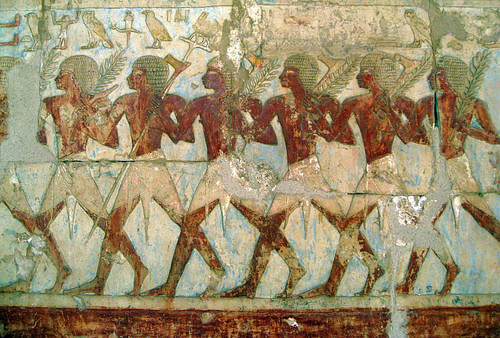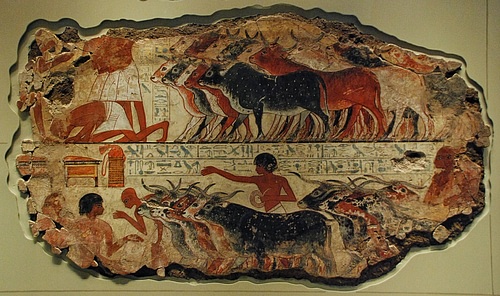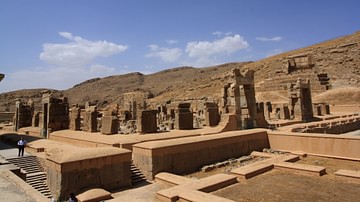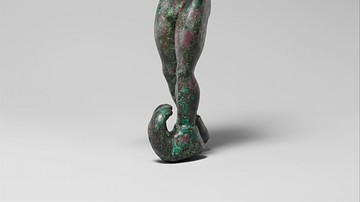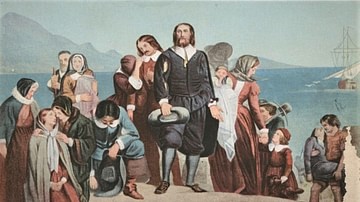Ancient Egypt is defined as the civilization which flourished in North Africa between c. 6000-30 BCE – from the Predynastic Period in Egypt (c. 6000 - c. 3150 BCE) through the Ptolemaic Dynasty (323-30 BCE) before Egypt became a province of Rome. Roman Egypt (30 BCE - 646 CE) afterwards fell to the invasions of the Muslim Arabs.
For thousands of years, the civilization of Egypt was among the most significant in the ancient world and its kings were considered the living representatives of the divine on earth. The central value of Egyptian culture was balance – personified by the goddess Ma'at – and this encouraged a stable social platform from which people could explore the world and advance their understanding of how to live in it and, further, what waited in the afterlife beyond death.

The ancient Egyptians developed a highly sophisticated culture which made significant advances in medical practices and procedures, architectural and construction innovations, the development of literary motifs in poetry and prose, religious belief and tradition, and a vision of the afterlife which was grander and more comforting than any other of its time.
The following are ten facts about Egypt in answer to the most commonly asked questions:
What Is the Difference between Kingdom Periods & Intermediate Periods?
The ancient Egyptians had no demarcations between eras of their civilization. Events were dated from the rule of kings or memorable events, whether natural – such as floods, bad harvests, especially good harvests, or 'signs' attributed to the gods – or historical such as great military victories or building projects. Designations such as 'kingdoms' and 'intermediate periods' come from scholars in the modern day in an effort to make it easier to study the immense breadth of Egyptian civilization.
The history of ancient Egypt is therefore broken into different eras. The dates differ sometimes owing to the system scholars choose to use but the generally accepted dates are:
- Predynastic Period: c. 6000 - c. 3150 BCE
- Early Dynastic Period: c. 3150 - c. 2613 BCE
- Old Kingdom: c. 2613-2181 BCE
- First Intermediate Period: 2181-2040 BCE
- Middle Kingdom: 2040-1782 BCE
- Second Intermediate Period: c. 1782 - c. 1570 BCE
- New Kingdom: c. 1570 - c. 1069 BCE
- Third Intermediate Period: c. 1069-525 BCE
- Late Period of Ancient Egypt: 525-323 BCE
- Ptolemaic Period: 323-30 BCE
The difference between 'kingdoms' and 'intermediate periods' has to do with the centralization of rule. During the kingdoms, there was a monarch governing from a central location, the economy and society was stable, and there was discernible cultural progress. During the intermediate periods, Egyptian government was divided between locations, there was less stability, and physical evidence shows fewer cultural advances. Even so, the intermediate periods were nowhere near as chaotic as the scholars of the 19th-20th centuries CE interpreted them.
Who Was the Pharaoh of the Book of Exodus?
The most commonly cited Egyptian king for the unnamed pharaoh of Exodus is Ramesses II (the Great, r. 1279-1213 BCE) and the second most-cited is Akhenaten (r. 1353-1336 BCE) although various writers through the years have claimed many others. There is actually no historical, textual, or physical evidence that the Hebrews were enslaved in Egypt at any time in any great numbers.
There is ample evidence that the people who built the pyramids and other great monuments of Egypt were Egyptians who were either skilled workers or unskilled laborers who were expected to devote time to community service – such as public building projects – at the times when the Nile River flooded and farming was impossible. In spite of the claims of many through the years, the Exodus story is a cultural myth and there was no actual pharaoh who enslaved the Israelites because they were never enslaved en masse in Egypt. Slaves were taken from various lands after military victories or in sale by traders and were primarily used in the mines and by royalty. There may have been Hebrew slaves among these but not in the numbers given in the biblical narrative.
What Was the Egyptian Army like & How Was It Organized?
In the period of the Old Kingdom of Egypt, the army was made up of conscripts from various districts (nomes) under the leadership of a regional governor (nomarch). The nomarch organized his men and sent the company to the king. During the First Intermediate Period of Egypt, this system broke down as each individual nomarch gained greater power with the fall of the central government and used their militia to pursue their own agenda. In the Middle Kingdom of Egypt, the king Amenemhat I (r. c. 1991-1962 BCE) created the first standing army. The military was improved upon during the Second Intermediate Period of Egypt through contributions from the Hyksos such as the horse-drawn chariot, the composite bow, the scimitar sword, and bronze dagger. By the time of the New Kingdom of Egypt, the Egyptian army was a highly trained, professional fighting force which helped to create and maintain the Egyptian Empire.
The army was organized into divisions which were each named for a principal deity and were comprised of approximately 5,000 men. Each division had an officer who oversaw 50 soldiers and reported to a superior in charge of 250 who, in turn, reported to a captain who was under a troop commander. The troop commander was responsible to the troop overseer who reported to the fortification overseer (in command of where the troops were stationed) who was under a lieutenant commander who reported to a general. The general was directly under the supervision of the Egyptian vizier who reported to the pharaoh.
Egyptian warfare was never aimed at conquest but, rather, defense and stability. Even during the rise of the Egyptian Empire, the armies were used to create – and then maintain – a buffer zone around Egypt to prevent invasion but never went further than it needed to in order to maintain order. Part of the reason for this was the Egyptian religion and the belief that, if one died outside of Egypt's borders, one's soul would have a harder time reaching the paradise of the Field of Reeds.
What Was Egyptian Religion Like & How Did It Influence People?
Egyptian religion infused every aspect of the individual's daily life. The gods were ever-present and were thought to have given humanity the most perfect place in which to live with all the necessities and luxuries one could ask for. All the gods asked for in return was that people honored them through worship and maintained the celestial order known as ma'at – harmony – which bound all things together.
To the ancient Egyptians, life on earth was only one part of a much grander journey toward eternal happiness in an afterlife which was a mirror image of one's life on earth. After death, the soul was guided to the Hall of Truth where its heart was weighed in the balance against the white feather of truth of the goddess Ma'at by the great god Osiris. If one's heart was found lighter than the feather, one moved on toward the Field of Reeds; if heavier, the heart was dropped to the floor where it was eaten by a monster and the soul ceased to exist. The Egyptian Book of the Dead was written as a guide for the soul to help it avoid any pitfalls in the afterlife and find its way to paradise safely.
This belief influenced the daily lives of the Egyptians in that it was understood that one's existence was not confined by the time between one's birth and death but one was an immortal soul, journeying on earth for a certain time, but essentially an eternal being who would one day live among the gods in a paradise where all they had lost was returned to them.
Why Did the Egyptians Mummify Their Dead?
The Egyptians believed the soul was constituted of nine separate parts:
- Khat was the physical body
- Ka was one's double form
- Ba was a human-headed bird aspect which could speed between earth and the heavens
- Shuyet was the shadow self
- Akh was the immortal, transformed self
- Sahu and Sechem were aspects of the Akh
- Ab was the heart, the source of good and evil
- Ren was one's secret name
The physical body (khat) needed to be preserved so the Ka and Ba could recognize itself and the Akh could continue on to The Field of Reeds. In Egyptian burial rites, grave goods were included in the tomb of the deceased so they could be used in the afterlife and these would only be of value if the body remained intact. Contrary to popular belief, the Egyptians were not obsessed with death; they enjoyed life so much they never wanted it to end and this encouraged the belief in an eternal realm where one would live forever, enjoying all one did in life, in the presence of the gods.
Is There Any Truth to the Curse of Tutankhamun/the Curse of the Pharaohs?
There is no truth to the famous Curse of the Pharaohs which gained notoriety after the archaeologist Howard Carter opened the tomb of Tutankhamun in November of 1922 CE. Of the 58 people present when the tomb and sarcophagus were opened, only eight died within the next twelve years, and all of quite reasonable and rational causes, having nothing to do with the tomb. The myth of the Curse of Tutankhamun began in 1923 CE when the bestselling writer Marie Corelli (l. 1855-1924 CE) sent a letter to the magazine New York World quoting from an ancient text she claimed to own which warned of terrible consequences for any who disturbed the tombs of the kings of Egypt. Corelli was a popular novelist at the time, and her letter received a great deal of attention.
Howard Carter, at this same time, was increasingly frustrated by the many visitors interfering with his work at Tutankhamun's tomb, and Corelli's letter – which was popularized by the press – had exactly the effect he would have wished for in scaring people away. Carter could proceed with the excavation and examination of the tomb without further distraction and so never contradicted Corelli's claim – even though there was never any evidence she owned any ancient text and no evidence of any curse. Hollywood movies would further popularize the “Mummy's Curse” and embed it in the collective consciousness of the modern day.
What Food Did the Egyptians Eat?
The Egyptian diet was mainly vegetarian. Meat could not be stored as the Egyptians had no refrigeration and so was eaten shortly after slaughter at festivals, banquets, and by the upper class who had the leisure to hunt large game. Poultry and fish were eaten by every social class. The staples of the Egyptian diet were bread and beer. Although wine was made (from grapes as well as other fruit), it was mainly the drink of the upper class. Beer was the most popular drink – consumed at every meal of the day – as it was considered healthier than drinking from the Nile or streams which could be polluted and was believed to promote a lighter spirit and contented heart. Workers' wages, in fact, included a ration of beer and bread.
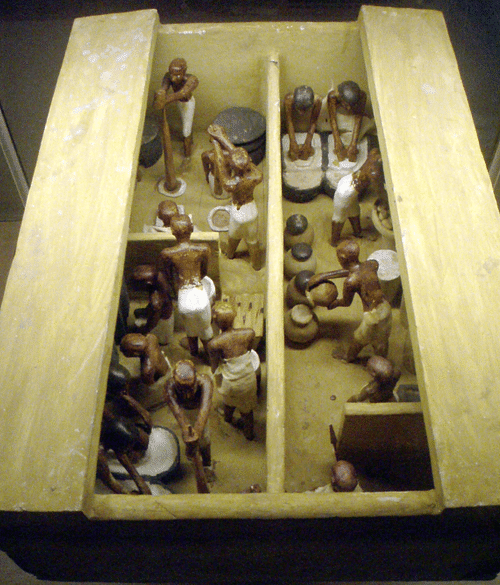
Vegetables and fruits made up most of the rest of the Egyptian diet, including onions, lentils, leeks, garlic, olives, pomegranate, grapes, dates, and figs. Wealthy Egyptians enjoyed coconuts which were among the most popular imported luxury goods. Cows, goats, and sheep were raised for milk which also provided cream, curds, and whey while bulls (aside from the sacred Apis Bull) were raised for manual labor on farms. The Egyptians also enjoyed a wide array of spices and oils with their meals including sesame, flax seed, cinnamon, cumin and – the most popular – horseradish. Different foods were often prescribed by physicians as remedies and, in Egyptian medicine, diet was recognized as a major factor in one's health.
What Was Daily Life Like in Ancient Egypt?
Egyptian society was based on a hierarchy which descended down, from highest to lowest:
- King (known as pharaoh only after the New Kingdom period) and royal family
- Vizier
- Members of the court
- Priests and scribes (including physicians)
- Regional governors
- Military leaders
- Artisans and craftspeople (including skilled workers)
- Workplace supervisors
- Unskilled workers and farmers
- Slaves
Social mobility was not encouraged because it was thought that the social order had been decreed by the gods in keeping with ma'at and so maintaining it was vital in keeping harmony and balance in the land. It was the king's responsibility to ensure ma'at was upheld at every level but, with very rare exceptions, everyone understood their place and behaved accordingly.
The economy was based on agriculture and most of the lower class were farmers. A farmer's day began at sunrise when he (and sometimes his wife and children) went to the fields and ended at dusk when they returned home for the evening meal. Trade was conducted through the barter system until c. 525 BCE when the coin system was introduced by the Persians. The monetary unit in place before that was the deben, which was a set value on a product.
In their leisure time, the upper class hunted, played sports, fished, played board games, and watched sporting events and, except for hunting big game, the lower class enjoyed these same pastimes as well as swimming and boating. The Egyptians enjoyed parties and festivals and the various gods' birthdays and other events were celebrated by national holidays when work was suspended and everyone gathered to drink, eat, and dance.
Were There Any Great Female Rulers Besides Cleopatra?
Although Cleopatra VII (l. c. 69-30 BCE) is arguably the most famous Egyptian queen, she was not actually Egyptian, but Greek, the last monarch of the Hellenistic Ptolemaic Dynasty. There were many other great Egyptian queens throughout the nation's history, however. In the Early Dynastic Period in Egypt, there was Neithhotep of the First Dynasty of Egypt (c. 3150 - c. 2890 BCE) and Merneith (l. c. 2990 BCE). In the Old Kingdom, Queen Heterpheres I (wife of king Sneferu, r. c. 2613-2589 BCE) was the mother of King Khufu (r. 2589-2566 BCE) and exercised considerable influence over him. One of the most controversial queens of this same period was Nitocris (c. 2184-2181 BCE) who is said to have avenged her brother's murder by inviting his killers to a banquet in an underground chamber and then drowning them. It should be noted, however, that scholars continue to debate the truth of this story and whether this queen even existed.
In the Middle Kingdom, Queen Sobeknefru reigned (c. 1807-1802 BCE), and this period also saw the development of the honorary title of God's Wife of Amun which would elevate the women who later held it to influential positions. Queen Ahhotep I (c. 1570-1530 BCE) is the first known powerful woman to have held the title at the beginning of the New Kingdom, and she passed it to her daughter-in-law Ahmose-Nefertari (c. 1570-1544 BCE) who would pass it on to others. Some of the greatest and best-known queens come from the New Kingdom period such as Hatshepsut (r. 1479-1458 BCE), Tiye (wife of Amenhotep III, r. c. 1386-1353 BCE), Nefertiti (c. 1370-1336 BCE), wife of Akhenaten, who took over his responsibilities when he neglected them for religious pursuits. There was also Nefertari (l. c. 1255 BCE) wife of and inspiration to Ramesses the Great, who is famously depicted at Abu Simbel.
In the Third Intermediate Period, some of the most powerful women held the title of God's Wife of Amun such as Amenirdis I (c. 714-700 BCE) who ruled Upper Egypt. A later God's Wife of Amun, Nitokris I (also known as Neitiqert, c. 655-585 BCE), ruled almost all of Egypt and was the wealthiest of all the God's Wives in the history of the title. By the time Cleopatra VII took the throne, Egypt already had a long history of powerful women in positions of authority.
What Are Some Cultural Legacies of Ancient Egypt?
Ancient Egypt contributed a number of inventions and innovations regularly used in the present day. The Egyptians placed a high value on personal hygiene and so daily bathing, combs and brushes, make-up (used by both women and men), and perfumes were all either invented or improved upon by them. They also invented the toothbrush and toothpaste, the breath mint, and deodorant in the form of incense. Dentistry was also developed by the Egyptians, as was the physician's practice of taking a patient's history in diagnosing illness. Women, as well as men, were doctors and some of the first clinics and medical schools in the world were established in Egypt.
Egyptian architecture developed the true pyramid and the obelisk as well as the techniques by which these were made and raised. Although engineers in the present day still do not understand how the Egyptians built, moved, and erected most of their great monuments, the structures inspired later cultures to emulate the forms. In agriculture, the Egyptians learned irrigation methods from the Hyksos and improved upon the light and heavy gauge ox-drawn plow. They also developed Babylonian concepts of astronomy and astrology, the calendar, and mathematics.
Egyptian literature, especially of the Middle Kingdom, established the form of the romantic ballad and literary/philosophical dialogue (later made famous by Plato's works). The religion and philosophy of the Egyptians has long been recognized as influencing Greek philosophy as well as later religions such as Christianity and Islam, especially through the concepts of eternal life, judgment after death, and rewards/punishments in the afterlife.

